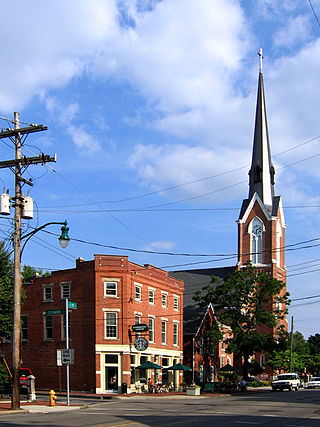
German Village is a historic neighborhood in Columbus, Ohio, just south of the city's downtown. It was settled in the early-to-mid-19th century by a large number of German immigrants, who at one time comprised as much as a third of the city's entire population. It became a city historic district in 1960 and was added to the National Register of Historic Places in 1974, becoming the list's largest privately funded preservation district, and in 2007, was made a Preserve America Community by the federal government. In 1980, its boundaries increased, and today it is one of the world's premier historic restorations.
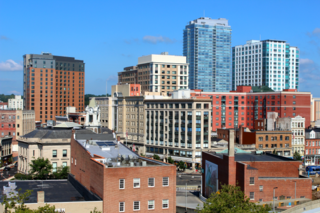
Downtown Stamford, or Stamford Downtown, is the central business district of the city of Stamford, Connecticut, United States. It includes major retail establishments, a shopping mall, a university campus, the headquarters of major corporations and Fortune 500 companies, as well as other retail businesses, hotels, restaurants, offices, entertainment venues and high-rise apartment buildings.
Columbus, the state capital and Ohio's largest city, has numerous neighborhoods within its city limits. Neighborhood names and boundaries are not officially defined. They may vary or change from time to time due to demographic and economic variables.

Broad Street Christian Church is a historic church building on the near east side of Columbus, Ohio, United States. The edifice was constructed in an exclusive residential neighborhood at the beginning of the twentieth century, and it has been designated a historic site. It was home for most of its history to a Disciples of Christ congregation, and is now the seat of an Ethiopian Orthodox congregation.
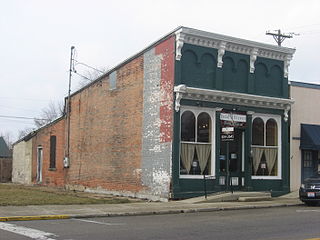
The Village Hobby Shop is a historic building in the village of Mechanicsburg, Ohio, United States. Built on Main Street in the late 19th century, it is one of the village's oldest extant commercial buildings, and it has been named a historic site.

The John H. Clark House is a historic residence in the village of Mechanicsburg, Ohio, United States. Built during Mechanicsburg's most prosperous period, it was the home of a prominent local doctor, and it has been named a historic site because of its historic architecture.

Lawler's Tavern is a historic commercial building in the village of Mechanicsburg, Ohio, United States. Built in 1830, it is one of the oldest buildings in the community, and it has been named a historic site.

The Holderness Inn is a former 19th century hotel building on United States Route 3 in Holderness, New Hampshire. Built in 1895–96, it is the only such building standing in the Squam Lake area, from a period when there were a significant number of resort hotels around the lake. The building was listed on the National Register of Historic Places in 1984. It is now owned by the Squam Lakes Natural Science Center, and is open seasonally as an art gallery and craft showroom.

Engine House No. 6, also known as the East Franklinton Engine House, is a former Columbus Fire Department station in the East Franklinton neighborhood of Columbus, Ohio. The building was constructed in 1892, designed in the Romanesque Revival style by John Flynn. The station was decommissioned in 1966, and served as an electronics store from 1975 to 2014. It was listed on the National Register of Historic Places in 2016, accompanying planned renovations. The station has been planned to be sold since about 2016, originally to the Columbus Historical Society and Heritage Ohio, though the latter organization now plans to move to the Ohio History Center. The historical society acquired the building in November 2021, and is restoring it with plans to turn it into the city's first permanent local history museum.

The General William Henry Harrison Headquarters is a historic building in the East Franklinton neighborhood of Columbus, Ohio. It was listed on the National Register of Historic Places in 1972 and the Columbus Register of Historic Properties in 1985. The brick house was built in 1807 by Jacob Oberdier, one of Franklinton's first settlers. The house became especially important to the area from 1813 to 1814, when General William Henry Harrison, later the 9th President of the United States, used the house as his headquarters. It is the only remaining building in Ohio associated with Harrison.

The Krumm House is a historic building in the Brewery District neighborhood of Columbus, Ohio. It was listed on the National Register of Historic Places and Columbus Register of Historic Properties in 1982. The brick house was built c. 1885. The building was home to Alexander W. Krumm, the Columbus City Solicitor from 1878 to 1883. The property is also one of few remaining late 19th century houses on South High Street.
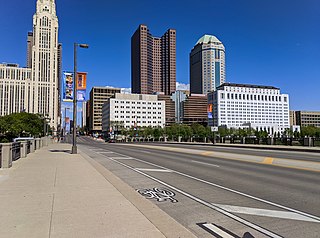
Broad Street is a major thoroughfare in Central Ohio, predominantly in Franklin County and Columbus. It stretches east from West Jefferson at Little Darby Creek to Pataskala. The street is considered one of Columbus's two main roads, along with High Street.
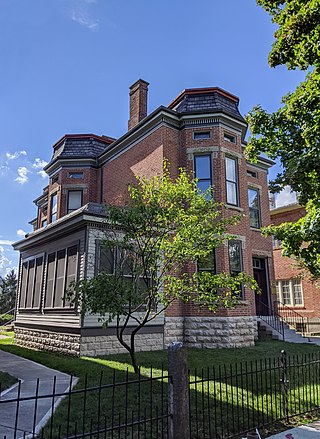
The Columbus Landmarks Foundation, known as Columbus Landmarks, is a nonprofit historic preservation organization in Columbus, Ohio. The foundation is best-known for its list of endangered sites in the city and its annual design award, given to buildings, landscapes, and other sites created or renovated in Columbus. It was established in 1977 as a project of the Junior League of Columbus, Ohio, following the demolition of the city's historic Union Station. It is headquartered at 57 Jefferson Avenue, a contributing structure in the Jefferson Avenue Historic District in Downtown Columbus.

The Felton School was a public school building in the Mount Vernon neighborhood of Columbus, Ohio, and a part of the Columbus Public School District. It was listed on the National Register of Historic Places in 1984 and the Columbus Register of Historic Properties in 1985.

The Avery Pontiac Building is a historic building in Columbus, Ohio. It is located in Columbus's Near East Side, roughly between the Franklin Park and Olde Towne East neighborhoods. The building was added to the Columbus Near East Side District in 1978. It was individually listed on the Columbus Register of Historic Properties in 1984.

Tosheff's Restaurant and Hotel is a historic building in the Reeb-Hosack neighborhood of Columbus, Ohio. It was built in 1920 and was listed on the National Register of Historic Places in 2001. The restaurant and hotel are one of few remainders of the historic Steelton industrial area, and closely connected to the eastern European neighborhood there. The industrial district was centered on Parsons Avenue, and relied upon the Buckeye Steel Castings Company, American Rolling Mill Company, the Chase Foundry and Manufacturing Company, the Federal Glass Company, and the Seagraves firetruck manufacturing plant.

The Macon Hotel is a historic building in the Mount Vernon neighborhood of Columbus, Ohio. The hotel, completed in 1888, served noted jazz musicians in the 20th century. It was listed on the Columbus Register of Historic Properties in 1983.

University Hall is the main academic building at the Ohio State University in Columbus, Ohio. The building houses classrooms for several of the university's colleges and includes a museum on the ground floor.

The Bellows School, also known as the Bellows Avenue Elementary School, is a historic school building in the Franklinton neighborhood of Columbus, Ohio. The building was constructed for the Columbus Public School District in 1905, designed by local architect David Riebel and built by George Bellows Sr. The elementary school operated until 1977; since then the building has been mostly vacant. The building was deemed eligible for the National Register of Historic Places by the Ohio Historic Preservation Office in 2006. In 2014, a developer announced plans to renovate the structure, despite plans from Ohio's transportation agency to demolish it to expand nearby highway exit ramps.

Engine House No. 5 is a former Columbus Fire Department station in the German Village neighborhood of Columbus, Ohio. The building was constructed in 1894, designed in the Richardsonian Romanesque style by John Flynn. The station was decommissioned in 1968. From 1974 to 2002, the space was used for a restaurant and bar, also known as Engine House No. 5. In 2004, the building was converted for office use, and today is the Columbus branch of Big Red Rooster, a marketing company.























